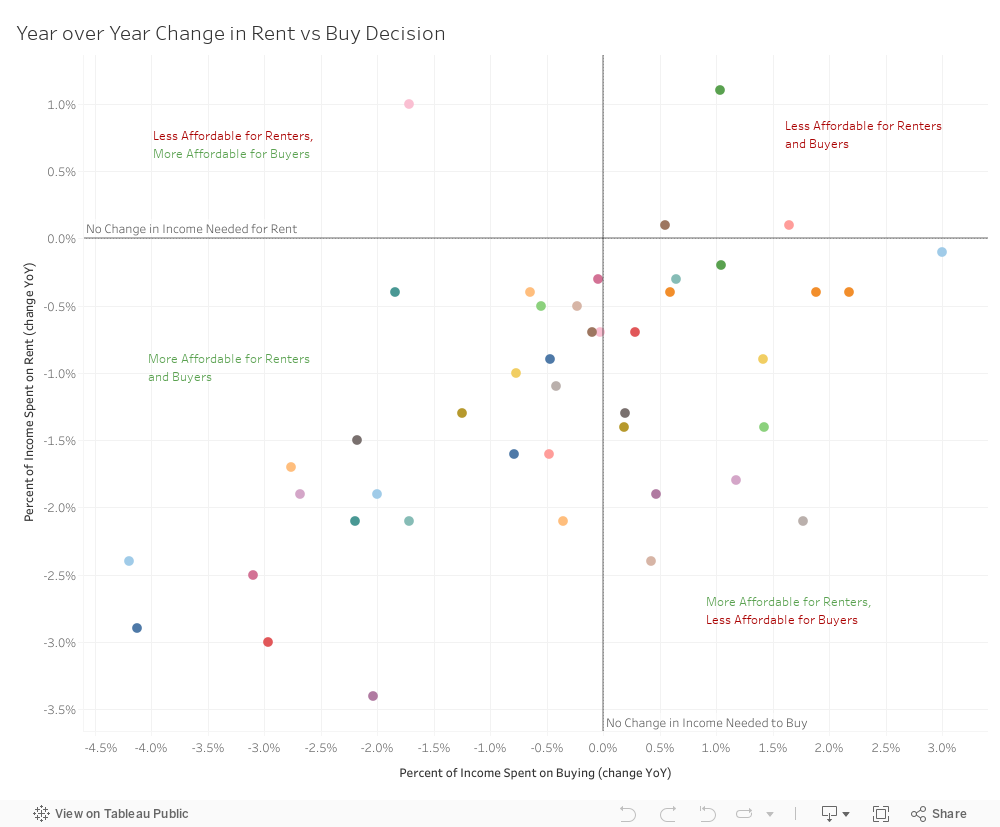12 major cities with increasingly affordable apartments as rent threatens to re-accelerate
Hagen Hopkins / Getty
- Rent growth has been accelerating in recent months, though prices are still in check.
- Apartment affordability could get stretched during a seasonally busy spring.
- Here are a dozen large US cities where rent is becoming more affordable.
Tenants should be on guard, as a brief winter slowdown in the rental market may end soon.
Rent growth rose on a year-over-year basis at the fastest pace in over 12 months in February, according to fresh rental data from listings site Zumper. One-bedroom fixtures were 2.9% more expensive than last year at $1,525, and two-bedroom units surged 3.7% to $1,905. Last month, rent increased by 2.5% and 3.2%, respectively, compared to the start of 2024.
Zumper
That swifter growth "is a nod to how much demand there is across the country, even at a time of record-high supply," said Zumper's Crystal Chen, who authored the report, in a message to Business Insider. Her firm said last summer that new apartment supply had hit a 50-year high.
Curiously, apartments were actually slightly cheaper this month than in January, when the median rate for one-bedroom setups was $1,534. The same was true last year, as going rates for one-bedroom apartments fell from $1,496 last January to $1,482 in February 2024.
But renters shouldn't count on more affordable apartments — in fact, the opposite may be true.
Back-to-back years of rent sliding from January to February could simply mean that more leases end in the first month of the year. A smaller pool of tenants deciding to move or re-up could translate to softer rental demand, which would temporarily cause apartment prices to pull back.
However, that relief likely won't last long, as price growth resumed in March before taking off in the late spring and early summer. Either way, the difference in median rents at the national level was just a few dollars in either direction, which is unlikely to be a major tipping point.
"Rents staying pretty flat on a monthly basis is pretty on trend with this time of year," Chen told BI. "Winter months see lower rental demand, so even as some leases end, limited competition keeps prices relatively stable until the busier spring and summer seasons."
12 top cities for deal-minded renters
Apartment prices in the 100 largest US cities that Zumper tracks each month foreshadow what's ahead for shelter inflation, which rose at the slowest rate in three years in January. But Zumper researchers are wary of leaning on lagging indicators more than their proprietary price data.
"Although shelter inflation has eased in recent months, its lagging nature — due to the way it's calculated — means the full impact has yet to be realized," said Zumper CEO Anthemos Georgiades in a statement for the report. He added: "The annual rent increases seen in our most recent data are likely to be reflected in CPI metrics over the coming months."
More than two-thirds of the biggest US rental markets experienced rent increases in February, up from just under that mark in January. Price hikes were most prevalent in regions with fewer available apartments, like the Northeast and Midwest, Chen remarked.
Conversely, higher-inventory cities in the once-trendy Sun Belt region saw some of the largest drops, though those declines were tempered relative to early 2024.
Business Insider analyzed Zumper's latest rental data and found a dozen cities where rent for one-bedroom apartments is both below the national median of $1,525 and down more than 1% from February 2024. Below are those 12 cities, along with their median rent, year-over-year and month-over-month rent changes, and the cost savings for renters versus the national median.
Sean Pavone/Shutterstock
One-bedroom median rent: $1,340
One-bedroom year-over-year rent change: -7.6%
One-bedroom month-over-month rent change: 3.9%
Cost savings vs national median: $194
Murat Taner/Getty Images
One-bedroom median rent: $1,000
One-bedroom year-over-year rent change: -4.8%
One-bedroom month-over-month rent change: 0%
Cost savings vs national median: $534
Photo by Mike Kline (notkalvin)/Getty Images
One-bedroom median rent: $1,420
One-bedroom year-over-year rent change: -4.7%
One-bedroom month-over-month rent change: -1.4%
Cost savings vs national median: $114
David Shvartsman / Getty Images
One-bedroom median rent: $1,290
One-bedroom year-over-year rent change: -4.4%
One-bedroom month-over-month rent change: 0%
Cost savings vs national median: $244
Keith J Finks/Shutterstock
One-bedroom median rent: $1,490
One-bedroom year-over-year rent change: -3.9%
One-bedroom month-over-month rent change: 0.7%
Cost savings vs national median: $44
Charles Knowles/Shutterstock
One-bedroom median rent: $1,300
One-bedroom year-over-year rent change: -3.7%
One-bedroom month-over-month rent change: 0%
Cost savings vs national median: $234
Little Vignettes Photo/Shutterstock
One-bedroom median rent: $1,450
One-bedroom year-over-year rent change: -3.3%
One-bedroom month-over-month rent change: -1.4%
Cost savings vs national median: $84
Lucky-photographer/Shutterstock
One-bedroom median rent: $1,210
One-bedroom year-over-year rent change: -2.4%
One-bedroom month-over-month rent change: 0.8%
Cost savings vs national median: $324
Grindstone Media Group/Shutterstock
One-bedroom median rent: $1,290
One-bedroom year-over-year rent change: -2.3%
One-bedroom month-over-month rent change: -3%
Cost savings vs national median: $244
Trong Nguyen/Shutterstock
One-bedroom median rent: $1,270
One-bedroom year-over-year rent change: -1.6%
One-bedroom month-over-month rent change: 1.6%
Cost savings vs national median: $264
4kodiak/Getty Images
One-bedroom median rent: $1,200
One-bedroom year-over-year rent change: -1.6%
One-bedroom month-over-month rent change: 5.3%
Cost savings vs national median: $334
f11photo/Shutterstock
One-bedroom median rent: $1,290
One-bedroom year-over-year rent change: -1.5%
One-bedroom month-over-month rent change: -2.3%
Cost savings vs national median: $244
